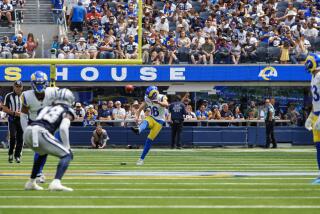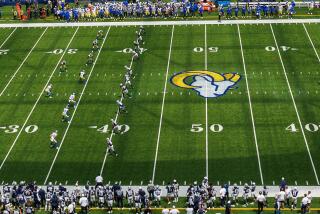Ask Sam Farmer: Why teams defer receiving the opening kickoff

Have a question about the NFL? Ask Times NFL writer Sam Farmer, and he will answer as many as he can online and in the Sunday editions of the newspaper throughout the season. Email questions to: sam.farmer@latimes.com
Question: Why is it much more common now for teams to defer receiving the ball in the first half of a game?
Martin Schwartz, Pacific Palisades
Farmer: It takes patience and restraint to defer until the second half, but if you have confidence in your defense, you could get an early field-position edge.
Three years ago, the NFL moved kickoffs from the 30 to the 35, making touchbacks much more common. So if you kick off and get a touchback, then force a three-and-out, you’re likely to get the ball back somewhere around your 35 or 40. Bingo! Great field position.
“You’d like to do that in the beginning of the game, rather than waiting until the second half, because that offensive possession isn’t nearly the same feeling-out process as the opening one is,” said Rick Neuheisel, who was UCLA’s coach and, before that, Baltimore’s offensive coordinator.
Not everyone wants to wait, of course.
“There are people that just like to get the ball,” Neuheisel said. “They think they have you dialed, and they want to set the tempo and just go. When somebody didn’t defer, I always thought they were just so excited to go offensively, and I’d always alert the defensive coordinator: Look for a double move, look for them to try for a big play, that they’d been talking to their team about, ‘Hey, we’re taking the ball.’¿”
::
Question: Why don’t teams try and block a field goal with a tall leaper in the end zone? You see guys dunk all the time, and clearly each team has several players that can get at least a foot or two over the goal post. Many of the long field goals seem to make it over by just a wee bit?
Craig Nadel, Santa Monica
Farmer: That’s a tantalizing thought, Calvin Johnson lurking on the back end like Hakeem Olajuwon, ready to swat away any football that violates his airspace. Alas, though, NFL rules don’t allow for that, banning “goal-tending by a defensive player leaping up to deflect a kick as it passes above the crossbar of a goal post.” The penalty, described as a “palpably unfair act,” is 15 yards and an automatic first down, or the team can choose to be awarded the field goal and 15 yards on the kickoff.
But such goaltending wasn’t always illegal. Back in the early 1970s, the Kansas City Chiefs would use 6-foot-10 tight end Morris Stroud, a former college basketball center, to stand under the crossbar and knock away low attempts. When the league banned that, the change was informally deemed the “Stroud Rule.” However, he didn’t pioneer that strategy. In the late 1950s, R.C. Owens, the gravity-defying San Francisco receiver (and father of the alley-oop catch), did the same thing.
More to Read
Go beyond the scoreboard
Get the latest on L.A.'s teams in the daily Sports Report newsletter.
You may occasionally receive promotional content from the Los Angeles Times.











